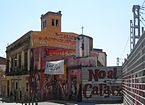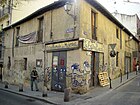
Squatting in Spain refers to the occupation of unused or derelict buildings or land without the permission of the owner. In Francoist Spain migrant workers lived in slums on the periphery of cities. During the Spanish transition to democracy, residential squatting occurred in Spanish cities such as Barcelona, Bilbao, Madrid, Valencia and Zaragoza. From the 1980s onwards a new generation of squatters set up self-managed social centres which hosted events and campaigns. The 1995 Criminal Code among other things criminalised squatting, but failed to stop it. Social centres exist across the country and in Barcelona and Madrid in particular. In the Basque Country they are known as gaztetxes.
Overview
Francoist Spain ended with the death of Francisco Franco in 1975. In the following year, the numbers of people striking increased from 500,000 to over 5 million and social movements blossomed. [1]: 127–128 During the Spanish transition to democracy, residential squatting occurred in cities such as Barcelona, Bilbao, Madrid, Valencia and Zaragoza. [2]: 119
In the 1970s, there were self-built informal settlements or slums as new industrialised zones in cities drew working class migrants from rural areas. [3]: 95 A contemporary slum is Cañada Real, where an estimated 40,000 to 50,000 people live along a 15km track formerly used as a drovers' road, on the boundary shared by Madrid and Rivas Vaciamadrid. [4] [5] Parts of the slum are notorious for drug-dealing. [6] Since it is deemed public land, the squatters are unable to gain possession by usucapión ( adverse possession). [4]
As of 2017, it took on average eight months for owners to regain properties from squatters. A company called Desokupa ("De-Squat") became notorious for evicting squatters without a legal process, for example La Yaya social centre in Argüelles, Madrid. [7] El Mundo stated in 2018 that there had been over 12,000 reported squats in that year, up from 7,739 in 2013. [8] Barcelona had the most reported squats, with 17,465 reported between 2013 and 2018. [8] During the COVID-19 pandemic in Spain, around 600 Roma people squatted properties on the Costa del Sol which had been impounded as part of Operation Malaya. [9]
Okupa

Young people were attracted to the new 1980s squatting movement and began to set up self-managed social centres, known as CSOAs (Centros Sociales Okupados y Autogestionados), which hosted infoshops and co-operatives, organised events and provided meeting space for campaigns. [2]: 119–121 The word okupa is derived from the Spanish verb "ocupar", meaning to occupy. [10] The letter "k" is seldom used in Spanish, so squatter activists used it to signify their radicality and their difference to mainstream culture. [11] The social centres has their antecedents in libertarian ateneus, countercultural spaces which were founded in many cities from the late 1970s onwards. [1]: 135 The 1995 Criminal Code among other things criminalised squatting but it did not stop the squatters movement from growing. [2]: 119–121
In Madrid, a key project in the 1980s was Minuesa. [12]: 181 Eskalera Karakola was a feminist squat, which was active from 1996 to 2005 before legalizing and taking a new building. [13] The squatter movement experienced a resurgence in the early 2010s as a result of the anti-austerity 15-M Movement. As of 2013, there were over thirty squatted social centres in Madrid. [14] Patio Maravillas was active from 2007 until 2015 in several different buildings. [15] La Ingobernable was evicted in 2020 during the state of alarm due to the COVID-19 pandemic in Spain. [16]
The number of squatted social centres in Barcelona grew from under thirty in the 1990s to around sixty in 2014, as recorded by Info Usurpa (a weekly activist agenda). [3]: 113 The influential Kasa de la Muntanya was occupied in 1989. [3]: 104 In 2014, the ultimately unsuccessful attempts to evict the long-running social centre of Can Vies provoked major riots. [17] Another long-running squat is Can Masdeu, which survived a concerted eviction attempt in 2002. Eleven occupiers suspended themselves off the walls of the building for several days. [3]: 114
The Basque Country is another area where a high number of houses have been occupied and social centres take the form of gaztetxes. [2]: 121 Influential projects in the 1980s included Bolsa de Bilbao, Gaztetxe de Gazteiz in Vitoria-Gasteiz and Euskal Jai in Pamplona. [12]: 181 The eviction of Kukutza in Bilbao was met with largescale protests in 2011. [18] On the outskirts of Vitoria-Gasteiz, the squatted neighbourhood of Errekaleor was occupied in 2013 and has around 150 inhabitants. [19]
Gallery
-
Kasa de la Muntanya, Barcelona-Vallcarca (2006)
-
C.S.A. Can Vies, Barcelona-Sants (2007)
-
Ruïna Amàlia, Barcelona (2007)
-
Interior of Bahía, Barcelona-Sants (2007)
-
Can Masdeu, Barcelona- Collserola (2009)
-
The former building of Eskalera Karakola, feminist squat in Madrid (2007)
-
Mural on exterior of Patio Maravillas (2013)
Housing movement
As a result of the Great Recession in the late 2000s, over 50% of young people aged between 16 and 34 were still living with their parents in 2011, since they were unable to afford to buy or rent. Despite the cost of renting being at relatively high level, the number of empty properties rocketed to 3.5 million out of a total of 35 million, again in 2011. [12]: 183 Many people lost their houses due to foreclosure, over 600,000 between 2008 and 2014. [12]: 184 This situation led to the foundation of the Plataforma de Afectados por la Hipoteca (PAH) (Platform for People Affected by Mortgages) in Barcelona in 2009. By 2018, there were 78 PAH groups in Catalonia and 245 in total in Spain. [12]: 187 The PAH used a variety of tactics to support tenants under threat of eviction, including street protests against banks and legal challenges. Between 2009 and 2017, it prevented 2045 evictions and rehoused over 2500 people by squatting properties owned by banks. [12]: 187–188 The PAH has points of agreement with the okupa movement and is also seen as reformist, since its leaders moved towards local government. For example, Ada Colau was a regional leader of the PAH in Barcelona and then became mayor, representing the party Barcelona en Comú ("Barcelona in common"). [12]: 189 The PAH uses the more conventional spelling of "ocupa" instead of "okupa" for a squat. [20]: 68
See also
References
- ^ a b Tudela, Enrique; Cattaneo, Claudio (2016). "Beyond Desencanto: The Slow Emergence of New Social Youth Movements in Spain During the Early 1980s". In Andresen, Knud; van der Steen, Bart (eds.). A European Youth Revolt. Palgrave Studies in the History of Social Movements. Palgrave Macmillan UK. pp. 127–141. doi: 10.1007/978-1-137-56570-9_9. ISBN 978-1-137-56570-9. Archived from the original on 1 October 2020. Retrieved 1 October 2020.
- ^ a b c d Martinez, Miguel (2013). "The Squatters' Movement in Spain". In Squatting Europe Kollective (ed.). Squatting in Europe : radical spaces, urban struggles. Wivenhoe [UK]: Minor Compositions. ISBN 9781570272578.
- ^ a b c d Tudela, Enrique; Cattaneo, Claudio (2014). "El Carrer es Nostre! The autonomous movement in Barcelona 1980-2012". In Katzeff, Ask; van der Steen, Bart; van Hoogenhuijze, Leendert (eds.). The city is ours: Squatting and autonomous movements in Europe from the 1970s to the present. Oakland: PM Press. ISBN 9781604866834.
- ^ a b ¿Ilegales para siempre?. Archived 2020-09-07 at the Wayback Machine, Javier Lafuente, El País, 19 March 2008.
- ^ De camino de ovejas a foco de marginalidad Archived 2010-10-31 at the Wayback Machine, José Luis Martín, El Mundo, 3 June 2004
- ^ La Cañada Real, foco de delincuencia y venta de droga Archived 2010-04-06 at the Wayback Machine, El Mundo, 18/10/2007.
- ^ Cussac, Pablo (20 November 2017). "Desokupa. Violent entrepreneurs and the making of tourist capitalism". Political Critique. Retrieved 1 October 2020.
- ^ a b Paz, Lorena Rojas; Rodriguez, Angy Alvarado (24 November 2019). "La ocupación ilegal de viviendas crece un 58% en cinco años". El Mundo (in Spanish). Archived from the original on 1 October 2020. Retrieved 1 October 2020.
- ^ Smith, John (28 April 2020). "One of Costa del Sol Spain's Wealthiest Communities Faces Problem with 600 Squatters during Lockdown". Euro Weekly News Spain. Retrieved 28 March 2021.
- ^ "Okupas — the Spanish Squatter Movement. Everything you need to know". virtoproperty.com. Retrieved 1 October 2020.
- ^ Fuentes, Juan Francisco (2017). "Usos ideológicos de la letra "K" en la España contemporánea: sobre el cambiante significado de un símbolo". Ariadna histórica. Lenguajes, conceptos, metáforas. (in Spanish). 6: 9–27. ISSN 2255-0968.
- ^ a b c d e f g Gonzalez, Robert (2019). Yip, Ngai Ming; Martínez López, Miguel Angel; Sun, Xiaoyi (eds.). Contested Cities and Urban Activism. The Contemporary City. doi: 10.1007/978-981-13-1730-9. ISBN 978-981-13-1729-3. S2CID 159239038.
- ^ Sanz, Segundo; Tejero, Raquel (7 March 2019). "Huelga 8 de marzo: Un centro de 'okupas' feministas financiado por ediles de Carmena está detrás de la huelga del 8M". okdiario (in Spanish). Archived from the original on 23 September 2020. Retrieved 1 October 2020.
- ^ Blanco, Julia Ramírez (4 March 2013). "Madrid's Renaissance of Occupied Spaces". The Nation. Retrieved 22 November 2020.
- ^ "Patio Maravillas". p2p plazas: a southern european network (in Spanish). 22 November 2015. Archived from the original on 1 October 2020. Retrieved 1 October 2020.
-
^ RAMOS AÍSA, LUCÍA; FRANCO, LUCÍA (24 April 2020).
"El Gobierno ejecuta el desalojo del nuevo edificio de La Ingobernable, vacío durante el estado de alarma". El Pais (in Spanish).
Archived from the original on 26 April 2020. Retrieved 1 October 2020.
La Ingobernable es un proyecto que va más allá de un espacio
- ^ Govan, Fiona (2014-05-30). "Squat demolition called off after four nights of rioting in Barcelona". The Telegraph. Archived from the original on 1 June 2014. Retrieved 1 June 2014.
- ^ "The Basque Country And A Peace Process That Spain Is Ignoring". AN SIONNACH FIONN. Ireland. 2011-09-26. Archived from the original on 2019-04-03. Retrieved 2019-04-03.
-
^ Azumendi, Eduardo (16 October 2019).
"El barrio 'okupa' de Errekaleor: "Nos han quitado la luz, pero tenemos más energía que nunca"". Archived from
the original on 16 June 2019. Retrieved 18 June 2019.
En total, 150, en lo que constituye una de las áreas urbanas ocupadas más grandes de España.
- ^ Debelle, Galvão; Cattaneo, Claudio; González, Robert; Barranco, Oriol; Llobet, Marta (2018). "Squatting Cycles in Barcelona: Identities, Repression and the Controversy of Institutionalisation". The Urban Politics of Squatters' Movements. pp. 51–73. doi: 10.1057/978-1-349-95314-1_3. ISBN 978-1-349-95313-4.







